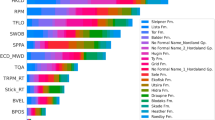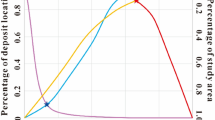Abstract
In advanced exploration projects or operating mines, the process of allocating capital for infill drilling programs is a significant and recurrent challenge. Within a large company, the different mine sites and projects compete for the available funds for drilling. To maximize a project’s value to its company, a drillhole location optimizer can be used as an objective tool to compare drilling campaigns. The fast semi-greedy optimizer presented here can allow for the obtention of close to optimal solutions to the coverage problem with up to three orders of magnitude less computing time needed than with integer programming. The heuristic approach is flexible as it allows dynamic updating of block values once new drillholes are selected in the solution, as opposed to existing methods based on static block values. The block values used for optimization incorporate kriging estimate and variance, estimate of indicator at cutoff grade and distances to existing or newly selected drillholes. The heuristic approach tends to locate new drillholes within the maximum risk areas, i.e., within less informed zones predicted as being ore zones. Applied to different deposits, it enables, after suitable normalization, comparison of different drilling campaigns and allocation of budgets accordingly.











Similar content being viewed by others
References
Bilal, N. (2014). Métaheuristiques hybrides pour les problèmes de recouvrement et recouvrementpartiel d’ensembles appliqués au problème de positionnement des trous de forage dans les mines.Ph.D. thesis Polytechnique Montréal.
Bilal, N., Galinier, P., & Guibault, F. (2013). A new formulation of the set covering problem formetaheuristic approaches. ISRN Operations Research, 2013.
Bilal, N., Galinier, P., & Guibault, F. (2014). An iterated-tabu-search heuristic for a variant of the partial set covering problem. Journal of Heuristics, 20, 143–164.
Chilès, J.-P., & Delfiner, P. (2012). Geostatistics. Berlin: Wiley. https://doi.org/10.1002/9781118136188.
Daoust, C., Voicu, G., Brisson, H., & Gauthier, M. (2011). Geological setting of the Paleoproterozoic Rosebel gold district, Guiana shield, Suriname. Journal of South American Earth Sciences, 32, 222–245.
Fatehi, M., Haroni, H. A., & Morshedy, A. H. (2017). Designing infill directional drilling in mineral exploration by using particle swarm optimization algorithm. Arabian Journal of Geosciences. https://doi.org/10.1007/s12517-017-3209-4.
Gershon, M., Allen, L. E., & Manley, G. (1988). Application of a new approach for drillholes location optimization. International Journal of Surface Mining, Reclamation, and Environment, 2, 27–31.
Hart, J. P., & Shogan, A. W. (1987). Semi-greedy heuristics: An empirical study. Operations Research Letters, 6, 107–114.
Jafrasteh, B., & Fathianpour, N. (2017). Optimal location of additional exploratory drillholes using a fuzzy-artificial bee colony algorithm. Arabian Journal of Geosciences, 10, 213. https://doi.org/10.1007/s12517-017-2948-6.
Journel, A. G. (1974). Geostatistics for conditional simulation of ore bodies. Economic Geology, 69, 673–687.
Journel, A. G. (1982). The indicator approach to estimation of spatial distributions. In Proceedings of the 17th APCOM international symposium. New York (pp. 793–806).
Karp, R. M. (1972). Reducibility among combinatorial problems. In Complexity of computer computations (pp. 85–103). Berlin: Springer. https://doi.org/10.1007/978-1-4684-2001-2_9.
Kim, Y. C., Myers, D. E., & Knudsen, H. (1977). Advanced geostatistics in ore reserve estimation and mine planning (practitioner’s guide). Technical report Arizona Univ.
Kirkpatrick, S., Gelatt, C. D., & Vecchi, M. P. (1983). Optimization by simulated annealing. Science, 220, 671–680.
Matheron, G. (1973). The intrinsic random functions and their applications. Advances in Applied Probability, 5, 439–468.
McBratney, A., Webster, R., & Burgess, T. (1981). The design of optimal sampling schemes for local estimation and mapping of regionalized variables—I: Theory and method. Computers and Geosciences, 7, 331–334.
Mohammadi, S. S., Hezarkhani, A., & Tercan, A. E. (2012). Optimally locating additional drillholes in three dimensions using grade and simulated annealing. Journal of the Geological Society of India, 80, 700–706.
Parker, H. M. (2012). Reconciliation principles for the mining industry. Mining Technology, 121, 160–176.
Pilger, G. G., Costa, J. F. C. L., & Koppe, J. C. (2001). Additional samples: Where they should be located. Natural Resources Research, 10, 197–207.
Pinheiro, M., Emery, X., Rocha, A. M. A., Miranda, T., & Lamas, L. (2017). Drillholes plans optimization methodology combining geostatistical simulation and simulated annealing. Tunnelling and Underground Space Technology, 70, 65–75.
Scheck, D. E., & Chou, D.-R. (1983). Optimum locations for exploratory drillholes. International Journal of Mining Engineering, 1, 343–355.
Soltani, S., Hezarkhani, A., Erhan Tercan, A., & Karimi, B. (2011). Use of genetic algorithm in optimally locating additional drillholes. Journal of Mining Science, 47, 62–72.
Zagré, G. E., Marcotte, D., Gamache, M., & Guibault, F. (2018). New tabu algorithm for positioning mining drillholes with blocks uncertainty. Natural Resources Research, 28, 609–629.
Acknowledgments
This research was made possible by National Research Council of Canada thru NSERC Grant (RGPIN-2015-06653). We thank IAMGOLD Corp. for providing data used in this study. The authors would like to thank Mehanaz Yakub for her help and advises.
Author information
Authors and Affiliations
Corresponding author
Rights and permissions
About this article
Cite this article
Dutaut, R., Marcotte, D. A New Semi-greedy Approach to Enhance Drillhole Planning. Nat Resour Res 29, 3599–3612 (2020). https://doi.org/10.1007/s11053-020-09674-8
Received:
Accepted:
Published:
Issue Date:
DOI: https://doi.org/10.1007/s11053-020-09674-8




